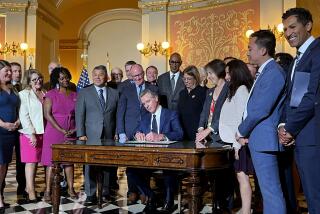Girding Against Gas Pains : Many in Southland Don’t Want Tax Hike Used to Cut U.S. Deficit
- Share via
Helen B. Hernandez, who drives 150 miles a day back and forth from her home in the Antelope Valley to her job in downtown Los Angeles, shares something in common with many long-haul commuters in Southern California: She keeps a sharp eye on gas prices.
“When (prices) went up to a dollar and a half, everybody was talking about it and nobody liked it--it really ate a hole in your pocket,” says Hernandez, a mechanic for the Southern California Rapid Transit District.
But the budget deficit that President-elect Bill Clinton is about to inherit seems to bulge with each recalculation and pressure is growing to find new ways to pay down the debt.
On Sunday, Vice President-elect Al Gore said in an interview on NBC’s “Meet the Press” that a gasoline tax hike “has not even been discussed as an issue.” Yet other recent reports have said that momentum is quietly building among presidential advisers to raise taxes on the nation’s primary transportation fuel.
One compelling argument: Every 1-cent increase in the gas tax brings more than $1 billion a year to the federal Treasury.
During the presidential campaign, candidates Paul Tsongas called for a gas tax hike of 30 to 50 cents phased in over 10 years and Ross Perot proposed a 50-cent hike over five years; Clinton denounced a 50-cent rise as “back breaking” to consumers.
Since then, however, the National Commission on the Environment, a nonpartisan group on which several Clinton advisers have served, has proposed a $1 increase over five years. One commission member, Alice Rivlin, who Clinton has named as deputy director of the Office of Management and Budget, advised the President-elect during last month’s economic conference in Arkansas that he “should be looking at taxing the things we don’t want to have happen, pollution and excessive use of energy, as an alternative to taxing the things we do want. . . . That means, perhaps, gas taxes.”
Numerous other advisers are urging higher gas taxes to not only lower the debt but also to conserve energy and reduce U.S. dependence on foreign oil.
Predictably, any gas price hike would meet opposition in Southern California, the world’s largest gasoline market, where private automobiles account for 95% of all travel by ground transportation, according to the Highway Users Federation.
Not that a gas tax hike would be particularly popular anywhere. Without much notice, most of the nation has become more, not less, like California in its dependence on the automobile. The Highway Users Federation estimates that U.S. drivers bought an average of 445 gallons of gasoline per capita in 1991. In the same period, Californians--who generally drive more fuel-efficient cars than drivers in other states--averaged 421 gallons. That compares to 524 gallons in Arkansas; 540 gallons in Georgia, and 462 gallons in Minnesota.
“Virtually every poll shows that a gasoline tax is the most unpopular form of taxation,” says J. Robinson West, president of Petroleum Finance Co., a Washington-based consultant and publisher.
“It’s a grudge tax, a very visible tax that people would pay frequently . . . every time you roll up to the pump,” West says. “The genius of withholding (tax from paychecks) is that people never remember it until April 15th.”
Gasoline taxes have another psychological disadvantage. Unlike retailers of other consumer products--from T-shirts to TVs--service station operators are required by state law to post prices that include all taxes.
“You go into a department store and you look at the prices . . . then you go to the cash register and they add that whopper, the tax, on top,” says Trilby Lundberg, publisher of the Lundberg Letter, which tracks retail gas trends. Lundberg says that is one reason many oil companies have traditionally opposed higher gas taxes. Consumers see tax hikes only as higher gasoline prices, making it harder for retailers to raise prices when their own costs go up.
As of Jan. 8, the average price in Los Angeles for a gallon of self-service regular unleaded gasoline was $1.28, with almost 41 cents of that total going for federal, state and county taxes. The breakdown of those figures is:
* Federal taxes: about 14 cents, with 2.5 cents of that amount devoted to federal deficit reduction. About a penny goes for mass transit, and the rest goes to the Highway Trust Fund for conventional transportation improvements.
* State taxes: 17 cents, most of which is used for streets and highways, and a small amount for mass transit.
* State and county sales taxes: Nearly 10 cents. Sales taxes go to governments’ general funds, which may use portions for transportation improvements.
In Southern California, many oil industry executives, environmentalists and transportation planners might accept a gas tax hike if it were used for transportation improvements, not to reduce the federal deficit.
In recent years, many U.S. oil companies have come to support higher gasoline taxes. Conoco Inc., for one, favors conserving petroleum to ensure long-term supplies for uses other than gasoline. DuPont, Conoco’s parent company, depends on oil as a feed stock in the manufacture of plastics and other materials.
Richard J. Stegemeier, chairman and chief executive of Unocal Corp., supports higher gasoline taxes, but not to pay off the national debt.
“I would not object if they were used for transportation, roads and bridges,” Stegemeier says. Chevron Corp., Atlantic Richfield Co. and other oil companies hold similar views.
And Californians as a whole agree. A 1988 study done for Californians for Better Transportation prior to the latest state gas tax hike, in 1990, suggested that a majority in the state would accept a 3-cent increase, but only if it went for improvements in transportation. Many environmentalists also want gas tax hikes, but favor investment in mass transit, mainly buses. This could balance, they say, the inequities of the tax.
Gasoline taxes are criticized because they represent a larger share of income for the poor or middle class than for the rich. Clinton advisers have suggested commensurate reductions in Social Security taxes, or tax credits, to soften the blow.
“But if you forgive some people of the economic pain, they will not reduce their consumption,” Stegemeier notes. A 10-cent increase would cost the average motorist $100 more a year, “and that wouldn’t chase many people away,” he predicts. “Fifty cents, or $500 a year, probably would.”
Yet once you chase people out of their cars, how do they get to work, particularly in Southern California? Deborah Gordon, a transportation expert with the Union of Concerned Scientists, would support a gas tax hike--but with a first priority to improve local mass transit.
“If you put the money into the bus systems in low-income areas,” Gordon says, “you would definitely benefit low-income people more than the middle class or the rich.” Gordon favors local authorities finding ways to tax gasoline before the federal government stiffens voter resistance by hiking the federal tax, since a tax “is more likely to be spent on transportation if it’s local.”
The Natural Resources Defense Council, however, prefers a broader tax on carbon--coal and other fossil fuels--not just gasoline. “The goal from an environmental perspective,” says Mary Nichols, head of the council’s Los Angeles office, “is to reduce our reliance on combustion as a source of energy for all kinds of activities, not just transportation.”
Whatever tax is proposed, public reaction may be tempered as well by changed attitudes about gasoline prices as well as the economy.
Consumers have become somewhat accustomed to price fluctuations since the oil shocks of the 1970s, says analyst Lundberg. Compared to previous decades, “it’s become a roller-coaster ride of prices up and down, (gasoline) consumption up and down,” Lundberg says.
And Nathaniel Spence, owner of Claremont Unocal, would be willing to accept a gas tax increase even though any cut in consumption would directly harm his service station’s sales.
“I voted for Perot, so I agree with that part of his revenue plan,” Spence says. “The government just needs to raise more money to straighten us out.”
Even Hernandez says she might favor a gas tax if the revenue would be used to ease commuters’ lives. “It would be nice to have a better transit system, a better train system,” she says.
The Economics of Gasoline
Cheaper in America
A look at gasoline taxes and pump prices in the industrialized nations shows that the United States imposes far lower state and federal taxes on gasoline than Western Europe or Japan.
A History of U.S. Gasoline Prices
Though much of the U.S. public believes gasoline prices are relatively high, when costs at the pump are adjusted to constant 1991 dollars, current prices are lower than at any time since World War II.
The Fuel Cost of Driving a Car
Increased fuel efficiency in automobiles, mandated by federal Corporate Average Fuel Economy standards, as well as generally lower gasoline prices in recent years, have reduced the cost of gasoline per mile driven from a high of 13.2 cents in 1980 to 5.4 cents in 1991.
Effect of Tax Hikes on U.S. Consumption
Since World War II, U.S. gasoline consumption has more than doubled. Many economists and environmenmtalists have called for higher federal gasoline taxes, to decrease use.
More to Read
Get the L.A. Times Politics newsletter
Deeply reported insights into legislation, politics and policy from Sacramento, Washington and beyond. In your inbox twice per week.
You may occasionally receive promotional content from the Los Angeles Times.










